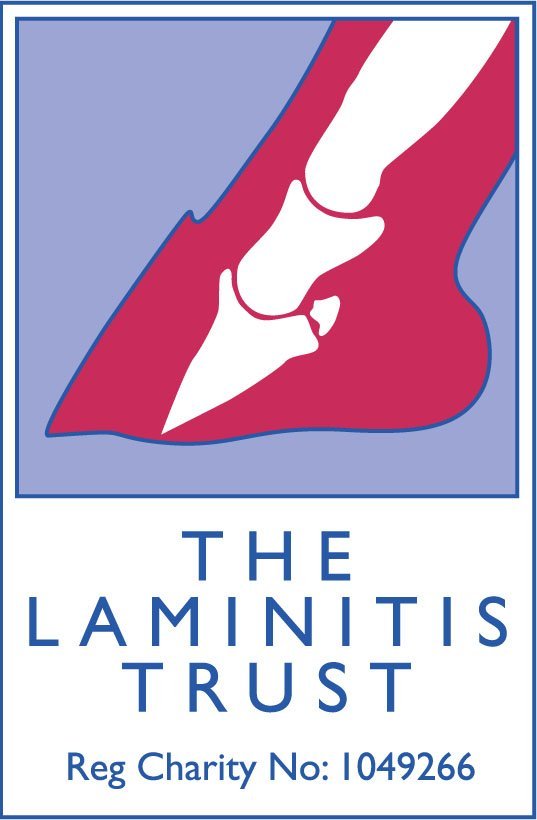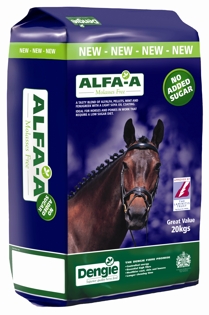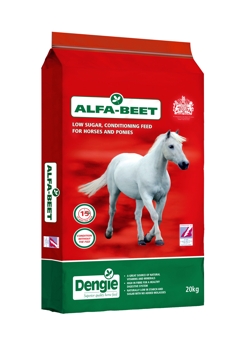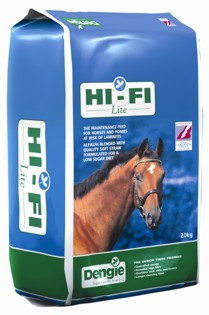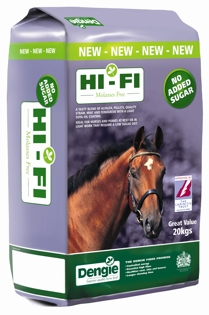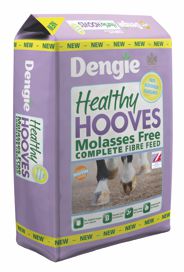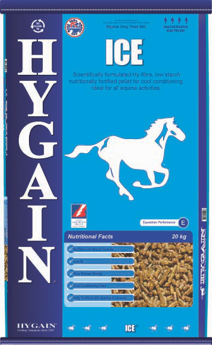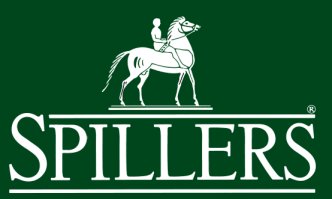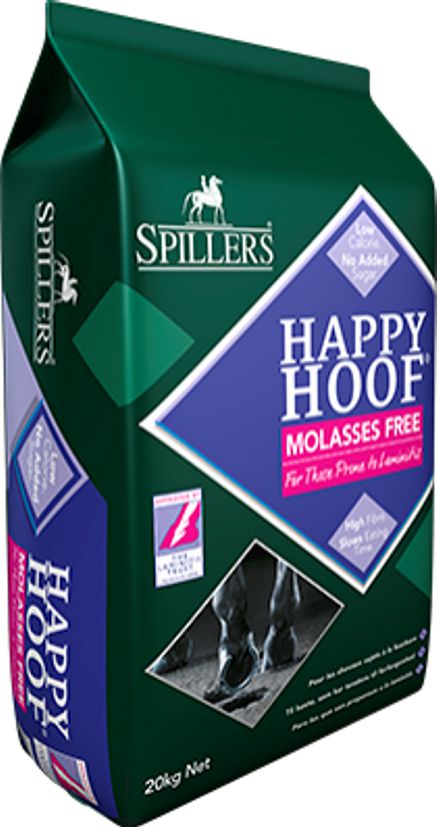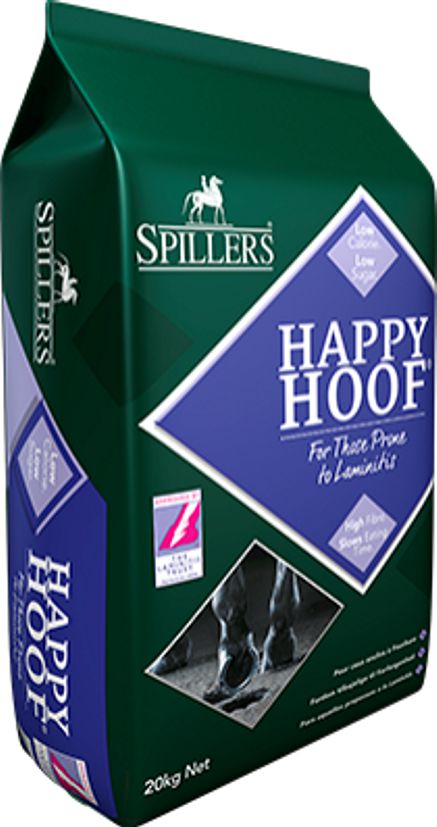|
Laminitis
Trust Feed Approval Mark Criteria
Introduction
These criteria
and associated guidelines are intended to help feed manufacturers seeking
approval for products by the Laminitis Trust. The criteria have been
drawn up by the Trust's scientific committee and must be met in full
in order to qualify for approval.
A. Analysis
and information required on submission
All methodology
must be carried out in accordance with recognised methods according
to the Feeding stuffs Legislation 2001.
1. A complete list
of raw materials with the range of weight of each raw material.
2. NSC by calculation (100- Analysis of Moisture, Crude, Protein, Fat,
Ash, NDF)
3. Water Soluble Carbohydrates, total starch (%) and digestible energy
(DE).
4. Lysine (%)
5. Macrominerals - calcium, phosphorus, magnesium, sodium, chloride,
potassium (%)
6. Microminerals - Copper, zinc, iron, selenium, iodine, manganese (mg/kg)
7. Vitamins A, D and E (iu/kg).
8. All analyses should be presented when the product is initially presented
for approval by the Laminitis Trust; the Trust reserves the right to
request re-analysis at any time.
9. Information regarding shelf life, pack sizes, bar codes
10. Details of the site of manufacture and quality control measures
employed
11. Copies of bag labelling and all promotional material connected with
the product including recommended feeding levels.
12. A letter of approval from the Veterinary Medicines Directorate signifying
their authorisation of the packaging and promotional material. Any proposed
amendment to promotional material for the approved product must be presented
to and be accepted by both the Veterinary Medicines Directorate and
Laminitis Trust before its introduction.
B. Criteria
1. The feed must
be capable of providing a minimum of 50% of a horse or pony's energy
requirements, when fed at the recommended rate.
2. Recommended feeding advice and rates for the complete diet should
satisfy the likely daily requirement for energy according to current
published information.
3. Inclusion of whole cereal grains, peas and beans is excluded with
the exception of where they are cooked or used to facilitate pelleting
and do not exceed 5% of the total feed.
4. NSC (%) must not exceed 40% of the dry matter of the feed (where
NSC is used as an estimate for the hydrolysable and rapidly fermentable
carbohydrate feed fractions).
5. Recommended feeding rate per meal should not allow NSC intake to
exceed 0.25% BW.
C. Literature & packaging
· Literature
carrying the Laminitis Trusts Logo, giving advice on reducing the risks
of Laminitis and specific information regarding the levels of feed that
are suitable to minimise the risk of Laminitis, should be clearly separated
from other commercial literature.
· Literature must stress the need to restrict grass intake where
a product could potentially be fed alongside grazing.
· The literature
must also indicate the risks of obesity in relation to Laminitis and
should suggest feeding rates to normalise bodyweight slowly in obese
animals.
· The packaging
should show the following wording " No prohibited substances, as
defined under FEI, BSJA or Jockey Club rules, have knowingly been used
in the manufacture of this product"
· Inclusion
of The Laminitis Trust advice panel as below is mandatory.
Feeding horses at high risk of Laminitis
Advice
from the scientific committee of the Laminitis Trust
Be
safe and sure, weigh all feedstuffs. Fat animals are at high risk of
laminitis; maintain your horse or pony at condition score 2½
to 3. If weight loss is necessary, the animal must be stabled or fitted
with a grazing muzzle. Feed intake should be reduced to achieve a slow
but steady loss under the supervision of your veterinary surgeon. Only
use Laminitis Trust Approved Feeds and limited long forage or restricted
grazing to avoid laminitis. Animals may require a nutritional supplement;
consult your veterinary surgeon for advice. Further information on Laminitis
is available at www.laminitis.org
| Zero grazing |
|
|
4 hours grazing on unfertilized pasture |
|
|
| Total feed daily |
300 kg Pony |
500 kg Horse |
|
300 kg Pony |
500 kg Horse |
| Approved product |
a kg |
b kg |
Approved product |
c kg |
d kg |
| Dried alfalfa (for example) |
e kg |
f kg |
Dried alfalfa (for example) |
|
g kg |
| Oat straw (for example) |
h kg |
|
Oat straw (for example) |
i kg |
j kg |
| Good quality hay |
k kg |
l kg |
Good quality hay |
m kg |
n kg |
a - n are weights
of feed
D. Conditions for Approval
1. An acceptance
that a representative of the Laminitis Trust may perform an annual inspection
of the manufacturing facility at a mutually convenient time.
2. The Trust's solicitors require an indemnifying letter absolving the
Laminitis Trust from any and all responsibility following any untoward
manufacturing accident or product toxicity be provided. A standard letter
is provided for you to complete and sign.
3. Successful applicants are required to pay an annual registration
fee before the "Approved Feed" logo is used by the company.
The Trustees have set this fee at £5000 annually per product for
the year 2002.
4. Should a product lose its registration for whatever reason, the company
must agree to remove the approval mark logo from bags, advertisements
and promotional material within 2 months of such notification or expiry
of the approved period. We provide a standard agreement to be signed.
5. No company may use the Approval Mark for a period of time following
withdrawal of the Approval Mark or following expiry of the licenced
period, without a subsequent application made in time for the next approved
period to run consecutively without interruption, equal to the period
between loss or expiry of registration and subsequent successful application
for the Approval Mark.
6. This information is provided as a guide to the criteria upon which
the scientific committee of The Laminitis Trust will base their decisions.
There may be specific features of individual products, which are not
referred to in this document upon which the committee takes a view.
The decision of the committee is final and no correspondence will be
entered into.
I. A. Silver, MA,
FRCVS
Robert A. Eustace FRCVS
David L. Frape PhD, FRCPath, FIBiol
The Scientific Committee of the Laminitis Trust
Nutritional and Clinical Research upon
which the above criteria are based.
Chemical
analytical method for feed products to be registered and requirements
of commercial literature to support the product.
General requirements
of analytical method
The chemical method should be capable of estimating the following contents
of the product:
(a) total starch,
(b) indigestible, rapidly fermentable carbohydrate, and
(c) neutral detergent fibre.
The method proposed
by Hoffman et al (2001) will allow these characteristics of the product
to be estimated.
Outline characteristics
of the analytical method
The evidence from the study of Hoffman et al (2001) would indicate that
a determination of:
the moisture, crude protein, fat, ash and NDF may provide the principal
data. From this the non-structural carbohydrate (NSC) may be calculated
by difference.
The NSC consists of hydrolysable carbohydrates (CHO-H) and rapidly fermentable
carbohydrate (CHO-FR). The majority of CHO-FR would reach the large
intestine, whereas the proportion of CHO-H reaching the large gut would
depend on:
(d) its digestibility, and
(e) the quantity of feed given in a meal.
If the product contains a significant proportion of mono- and di-saccharides,
which normally would be digested in the small intestine, they could
be extracted with boiling water. The remaining CHO-H could then, if
necessary, be determined following enzymatic hydrolysis of disaccharides
and starch (The proposal does not normally require CHO-H to be determined).
The data of Potter et al (1992), indicate that the starch intake per
meal should not exceed 0.4 % of body weight. However, this still constitutes
a large intake for animals at risk, and an intake of 0.25 % of bodyweight
is considered ample. Therefore, the value of (CHO-FR* plus CHO-H minus
sugars) should not exceed 0.25 % body weight per meal to provide a reasonably
low risk of diet-related laminitis.
Required (a) characteristics of products and (b) statements in the
commercial literature specifically directed towards laminitis prevention,
or towards a lowering the risk of its occurrence
1) Where the product constitutes the complete diet of the horse:
(i) the recommended feeding rate per meal should not allow the total
intake of
(a + b) in the methods section above to exceed 0.25 % of body weight;
Table
1
|
Bodyweight
(kg)
|
(a
+ b) kg, as 0.25 % BW
|
|
300
|
0.75
|
|
400
|
1.0
|
|
500
|
1.25
|
|
600
|
1.5
|
(ii) the crude
protein and simple sugars (mono- and di-saccharides) should not exceed
16 % and 7 % respectively of the product, assuming 12 % moisture content.
2) Where the product is designed to provide only part of the complete
diet of the horse:
(i) the product must be capable of providing at least half the daily
energy requirements of the horse, or, if not, other proposed energy
yielding constituents should be from the first list (Table 3) provided
below. Any proposed additional constituent to this list should be submitted
by name and chemical characteristics (chemical characteristics a, b,
& c, derived if necessary from the literature)* to the Laminitis
Trust for approval. Where the product provides more than half the daily
energy requirements then the other energy yielding constituents must
be provided from the second list below. (Proposed additions should have
the same constraints applied to them as apply to the additions in which
the product constitutes less than 50 % of the dietary energy).
(ii) The commercial literature related to reducing the risk of laminitis
must be separate from other literature, clear and acceptable for the
purpose of minimising laminitis risk and the advice should imply a low
risk of causing any ill-health when the animal is fed according to the
feeding instructions.
It is recognised by The Trust that pasture, as a feed source with major
risks, presents problems in both definition of its chemical characteristics
and quantity consumed per hour. Moreover, where a product is to be used
as an adjunct to grazing it can be difficult to persuade an animal to
eat an adequate quantity of the product, to decrease the risk and prevent
over-grazing. In this case there must be evidence that, first the product
would be consumed in significant quantities, so that the intake of pasture
herbage is significantly decreased and second that the literature is
clear concerning this potential cause of the disease. Recent evidence
indicates that fructans (and possibly other indigestible oligosaccharides)
present in pasture plants may be a major cause of laminitis in grazing
horses. It has been estimated that a 500 kg horse at pasture would on
average consume 1.8 kg of readily fermentable CHO-FR (b) per day (the
variation amongst horses and pastures will be considerable).
(iii) The literature should clearly indicate the risks associated with
body fat accumulation and that over-weight animals at risk should receive
approximately half their normal daily energy requirements until a normal
body weight is reinstated. The feeding system should take account of
the following energy requirements for maintenance of the horse:
Table
2
| Bodyweight
(kg) |
200
|
400
|
600
|
| Approx.
feed capacity per day (MegaJoules
MJ, Digestible energy DE) |
60
|
100
|
150
|
| Maintenance
requirement per day (MJ, DE) |
31
|
56
|
81
|
| Energy
requirements for work above maintenance |
|
|
|
| Walking
(1h) MJ, DE |
0.4
|
0.8
|
1.3
|
| Slow
trotting, some cantering (1h) MJ, DE |
4.2
|
8.4
|
12.5
|
Table 3
Supplementary energy-containing raw feed materials to be considered
as adjuncts to a registered product. (All feed ingredients must be of
good quality) The recommendations for their use must allow the total
feed to comply with the restrictions given. The calculation of their
non-structural carbohydrate (NSC, that includes both hydrolysable, CHO-H,
and fermentable CHO-FR ) may be derived from the data provided by NRC
(1989)*, where NDF values will be found.
(a) Those suitable for use where the registered Product constitutes
less than 50 % of the energy yielding dietary constituents.
Good quality hay,
Nutritionally improved straw, NIS,
Cereal straw,
Dried Lucerne,
Oatfeed,
Soya hulls
Vegetable oil,
Molasses (total sugar limit applies)
(b) Those suitable for use where the registered Product constitutes
more than 50 % of the energy yielding dietary constituents
Good quality hay,
Nutritionally improved straw, NIS,
Oatfeed,
Dried Lucerne,
Wheat bran,
Dried Grass pellets,
Sugar Beet pulp
Soya hulls
Vegetable oil,
Molasses (total sugar limit applies)
Additional requirements
for registration
(i) A complete list of ingredients must be given together with the range
of weight of each, in the proposed products.
(ii) A recent
independent analyst's report is required to provide the following product
details;
Table 4
| Total
crude protein |
|
Iodine |
|
| Neutral detergent
fibre |
|
Phosphorus |
|
| Lipids
(measured by hydrolysis) |
|
Magnesium |
|
| Ash |
|
Sodium |
|
| Moisture |
|
Chloride |
|
| Digestible
Energy |
|
Potassium |
|
| Total
Starch |
|
Zinc |
|
| Simple
Sugars |
|
Lysine |
|
| Vitamin
A |
|
Manganese |
|
| Vitamin
D |
|
Selenium |
|
| Vitamin E |
|
Copper |
|
| Calcium |
|
Iron |
|
(iii)
Feeding Instructions on the bag should include the following advice;
Advice
from the scientific committee of the Laminitis Trust
"Be safe and
sure, weigh all feedstuffs. Fat animals are at high risk of laminitis;
maintain your horse or pony at condition score 2½ to 3. If weight
loss is necessary, the animal must be stabled or fitted with a grazing
muzzle. Feed intake should be reduced to achieve a slow but steady loss
under the supervision of your veterinary surgeon. Only use Laminitis
Trust Approved Feeds and limited long forage or restricted grazing to
avoid laminitis. Animals may require a nutritional supplement; consult
your veterinary surgeon for advice. Further information on Laminitis
is available at www.laminitis.org."
Further information
including shelf life, pack sizes, bar codes, site of manufacture are
required. Copies of bag labeling and all promotional material connected
with the product including recommended feeding levels should be submitted.
Quality control measures employed at the manufacturing mill should be
stated and an acceptance that a representative of the Laminitis Trust
may perform an annual inspection of the manufacturing facility. The
Trust's solicitors also require that an indemnifying letter absolving
the Laminitis Trust from any and all responsibility following any untoward
manufacturing accident or product toxicity be provided.
References
Hoffman, R.M., Wilson, J.A., Kronfeld, D.S., Cooper, W.L., Lawrence,
L.A., Sklan, D. and Harris, P.A. (2001) J. Anim. Sci., 79, 500-506.
*NRC (1989), Nutrient
requirements of Horses, 5th Revised Edition.
Potter, G.D., Arnold,
F.F., Householder, D.D., Hansen, D.H. and Brown, K.M. (1992). Pferdeheilkunde
1: 107-111.
I. A. Silver, MA, FRCVS
Robert A. Eustace FRCVS
David L. Frape PhD, FRCPath, FSB
The Scientific Committee of the Laminitis Trust
The
decision of the Scientific Committee is final. No correspondence will
be entered into.
APPROVED
FEEDS
-----------------------------------------------------------------------------------------------------------------------------------------
-----------------------------------------------------------------------------------------------------------------------------------------
HYGAIN
Feeds Pty Ltd, PO Box 199, Officer Victoria 3809, AUSTRALIA Tel: +61 3 5943 2255
Email: sales@hygain.com.au
click
here to visit HyGain
|
|
----------------------------------------------------------------------------------------------------------------------------------------
|
|
